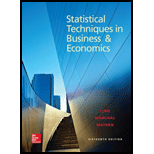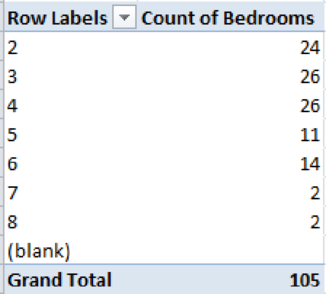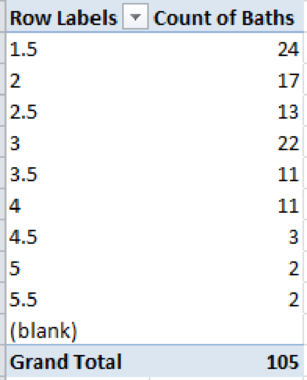
Concept explainers
Refer to the Real Estate data, which report information on homes sold in the Goodyear, Arizona, area last year.
- a. Create a
probability distribution for the number of bedrooms. Compute themean and the standard deviation of this distribution. - b. Create a probability distribution for the number of bathrooms. Compute the mean and the standard deviation of this distribution.
a.
Construct the probability distribution for the number of bedrooms.
Calculate the mean and standard deviation of this distribution.
Answer to Problem 70DE
The probability distribution for the number of bedrooms is as follows:
| Number of Bedrooms | Frequency |
Probability |
| 2 | 24 | 0.2286 |
| 3 | 26 | 0.2476 |
| 4 | 26 | 0.2476 |
| 5 | 11 | 0.1048 |
| 6 | 14 | 0.1333 |
| 7 | 2 | 0.0190 |
| 8 | 2 | 0.0190 |
| Total | 105 | 1 |
The mean of the distribution is 3.8.
The standard deviation of the distribution is 1.4954.
Explanation of Solution
Step-by-step procedure to obtain the frequency table for the number of bedrooms using EXCEL is given below:
- Enter the data in an EXCEL sheet.
- Go to Insert > PivotTable > PivotTable.
- In Table/Range, select the column Bedrooms and click OK.
- In PivotTable Field List, drag Bedrooms to Row Labels and to ∑ values.
- Click on it from ∑ values.
- Choose Value Field Settings.
- In Summarize value field by, choose Count and click OK.
The output obtained is as follows:

The probability distributions for the number of bedrooms are calculated as follows:
| Number of Bedrooms | Frequency |
Probability |
| 2 | 24 | |
| 3 | 26 | |
| 4 | 26 | |
| 5 | 11 | |
| 6 | 14 | |
| 7 | 2 | |
| 8 | 2 | |
| Total | 105 | 1 |
The mean of the distribution is calculated as follows:
Therefore, the mean of the distribution is 3.8.
Consider the following table that shows preliminary calculations to compute the standard deviation:
| Bedrooms | Frequency |
Probability | ||
| 2 | 24 | 0.2286 | ||
| 3 | 26 | 0.2476 | ||
| 4 | 26 | 0.2476 | ||
| 5 | 11 | 0.1048 | ||
| 6 | 14 | 0.1333 | ||
| 7 | 2 | 0.0190 | ||
| 8 | 2 | 0.0190 | ||
| 105 | 2.2362 |
The standard deviation of the distribution is calculated as follows:
Therefore, the standard deviation of the distribution is 1.4954.
b.
Construct the probability distribution for the number of bathrooms.
Find the mean and standard deviation for this distribution.
Answer to Problem 70DE
The probability distributions for the number of bathrooms are as follows:
| Number of Bathrooms | Frequency |
Probability |
| 1.5 | 16 | 0.1524 |
| 2 | 65 | 0.6191 |
| 2.5 | 15 | 0.1429 |
| 3 | 9 | 0.0857 |
| 105 |
The mean of the distribution is 2.0812.
The standard deviation of the distribution is 0.3912.
Explanation of Solution
Step-by-step procedure to obtain the frequency table for bedrooms using EXCEL:
- Enter the data in an EXCEL sheet.
- Go to Insert > PivotTable > PivotTable.
- In Table/Range, select the column Bathrooms and click OK.
- In PivotTable Field List, drag Bathrooms to Row Labels and to ∑ values.
- Click on it from ∑ values.
- Choose Value Field Settings.
- In Summarize value field by, choose Count and click OK.
The output obtained is as follows:

The probability distributions for the number of bathrooms are calculated as follows:
| Number of Bathrooms | Frequency |
Probability |
| 1.5 | 16 | |
| 2 | 65 | |
| 2.5 | 15 | |
| 3 | 9 | |
| Total | 105 | 1 |
The mean of the distribution is calculated as follows:
Therefore, the mean of the distribution is 2.0812.
Consider the following table that shows preliminary calculations to compute the standard deviation:
| Number of Bathrooms | Frequency |
Probability | ||
| 1.5 | 16 | 0.1524 | ||
| 2 | 65 | 0.6191 | ||
| 2.5 | 15 | 0.1429 | ||
| 3 | 9 | 0.0857 | ||
| Total | 105 |
The standard deviation of the distribution is calculated as follows:
Therefore, the standard deviation of the distribution is 0.3912.
Want to see more full solutions like this?
Chapter 6 Solutions
Statistical Techniques in Business and Economics
- The U.S. Postal Service will ship a Priority Mail® Large Flat Rate Box (12" 3 12" 3 5½") any where in the United States for a fixed price, regardless of weight. The weights (ounces) of 20 ran domly chosen boxes are shown below. (a) Make a stem-and-leaf diagram. (b) Make a histogram. (c) Describe the shape of the distribution. Weights 72 86 28 67 64 65 45 86 31 32 39 92 90 91 84 62 80 74 63 86arrow_forward(a) What is a bimodal histogram? (b) Explain the difference between left-skewed, symmetric, and right-skewed histograms. (c) What is an outlierarrow_forward(a) Test the hypothesis. Consider the hypothesis test Ho = : against H₁o < 02. Suppose that the sample sizes aren₁ = 7 and n₂ = 13 and that $² = 22.4 and $22 = 28.2. Use α = 0.05. Ho is not ✓ rejected. 9-9 IV (b) Find a 95% confidence interval on of 102. Round your answer to two decimal places (e.g. 98.76).arrow_forward
- Let us suppose we have some article reported on a study of potential sources of injury to equine veterinarians conducted at a university veterinary hospital. Forces on the hand were measured for several common activities that veterinarians engage in when examining or treating horses. We will consider the forces on the hands for two tasks, lifting and using ultrasound. Assume that both sample sizes are 6, the sample mean force for lifting was 6.2 pounds with standard deviation 1.5 pounds, and the sample mean force for using ultrasound was 6.4 pounds with standard deviation 0.3 pounds. Assume that the standard deviations are known. Suppose that you wanted to detect a true difference in mean force of 0.25 pounds on the hands for these two activities. Under the null hypothesis, 40 = 0. What level of type II error would you recommend here? Round your answer to four decimal places (e.g. 98.7654). Use a = 0.05. β = i What sample size would be required? Assume the sample sizes are to be equal.…arrow_forward= Consider the hypothesis test Ho: μ₁ = μ₂ against H₁ μ₁ μ2. Suppose that sample sizes are n₁ = 15 and n₂ = 15, that x1 = 4.7 and X2 = 7.8 and that s² = 4 and s² = 6.26. Assume that o and that the data are drawn from normal distributions. Use απ 0.05. (a) Test the hypothesis and find the P-value. (b) What is the power of the test in part (a) for a true difference in means of 3? (c) Assuming equal sample sizes, what sample size should be used to obtain ẞ = 0.05 if the true difference in means is - 2? Assume that α = 0.05. (a) The null hypothesis is 98.7654). rejected. The P-value is 0.0008 (b) The power is 0.94 . Round your answer to four decimal places (e.g. Round your answer to two decimal places (e.g. 98.76). (c) n₁ = n2 = 1 . Round your answer to the nearest integer.arrow_forwardConsider the hypothesis test Ho: = 622 against H₁: 6 > 62. Suppose that the sample sizes are n₁ = 20 and n₂ = 8, and that = 4.5; s=2.3. Use a = 0.01. (a) Test the hypothesis. Round your answers to two decimal places (e.g. 98.76). The test statistic is fo = i The critical value is f = Conclusion: i the null hypothesis at a = 0.01. (b) Construct the confidence interval on 02/022 which can be used to test the hypothesis: (Round your answer to two decimal places (e.g. 98.76).) iarrow_forward
- 2011 listing by carmax of the ages and prices of various corollas in a ceratin regionarrow_forwardس 11/ أ . اذا كانت 1 + x) = 2 x 3 + 2 x 2 + x) هي متعددة حدود محسوبة باستخدام طريقة الفروقات المنتهية (finite differences) من جدول البيانات التالي للدالة (f(x . احسب قيمة . ( 2 درجة ) xi k=0 k=1 k=2 k=3 0 3 1 2 2 2 3 αarrow_forward1. Differentiate between discrete and continuous random variables, providing examples for each type. 2. Consider a discrete random variable representing the number of patients visiting a clinic each day. The probabilities for the number of visits are as follows: 0 visits: P(0) = 0.2 1 visit: P(1) = 0.3 2 visits: P(2) = 0.5 Using this information, calculate the expected value (mean) of the number of patient visits per day. Show all your workings clearly. Rubric to follow Definition of Random variables ( clearly and accurately differentiate between discrete and continuous random variables with appropriate examples for each) Identification of discrete random variable (correctly identifies "number of patient visits" as a discrete random variable and explains reasoning clearly.) Calculation of probabilities (uses the probabilities correctly in the calculation, showing all steps clearly and logically) Expected value calculation (calculate the expected value (mean)…arrow_forward
- if the b coloumn of a z table disappeared what would be used to determine b column probabilitiesarrow_forwardConstruct a model of population flow between metropolitan and nonmetropolitan areas of a given country, given that their respective populations in 2015 were 263 million and 45 million. The probabilities are given by the following matrix. (from) (to) metro nonmetro 0.99 0.02 metro 0.01 0.98 nonmetro Predict the population distributions of metropolitan and nonmetropolitan areas for the years 2016 through 2020 (in millions, to four decimal places). (Let x, through x5 represent the years 2016 through 2020, respectively.) x₁ = x2 X3 261.27 46.73 11 259.59 48.41 11 257.96 50.04 11 256.39 51.61 11 tarrow_forwardIf the average price of a new one family home is $246,300 with a standard deviation of $15,000 find the minimum and maximum prices of the houses that a contractor will build to satisfy 88% of the market valuearrow_forward
 Glencoe Algebra 1, Student Edition, 9780079039897...AlgebraISBN:9780079039897Author:CarterPublisher:McGraw Hill
Glencoe Algebra 1, Student Edition, 9780079039897...AlgebraISBN:9780079039897Author:CarterPublisher:McGraw Hill Big Ideas Math A Bridge To Success Algebra 1: Stu...AlgebraISBN:9781680331141Author:HOUGHTON MIFFLIN HARCOURTPublisher:Houghton Mifflin Harcourt
Big Ideas Math A Bridge To Success Algebra 1: Stu...AlgebraISBN:9781680331141Author:HOUGHTON MIFFLIN HARCOURTPublisher:Houghton Mifflin Harcourt
 Holt Mcdougal Larson Pre-algebra: Student Edition...AlgebraISBN:9780547587776Author:HOLT MCDOUGALPublisher:HOLT MCDOUGAL
Holt Mcdougal Larson Pre-algebra: Student Edition...AlgebraISBN:9780547587776Author:HOLT MCDOUGALPublisher:HOLT MCDOUGAL



